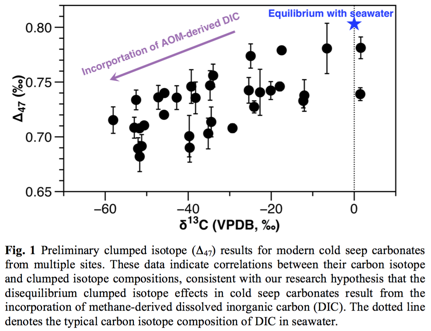Reports: ND256959-ND2: Clumped Isotope Composition of Cold Seep Carbonates: Patterns and Controls
Weifu Guo, PhD, Woods Hole Oceanographic Institution
Research Hypothesis and Objective
Anaerobic oxidation of methane (AOM) and other hydrocarbons at marine seep sites increases the seawater alkalinity, leading to the precipitation of large amount of authigenic carbonates in the shallow subsurface or at the seafloor. The isotopic composition of these cold seep carbonates reflect their formation environment and could provide important constraints on the subsurface environmental conditions and AOM activities. However, application of the recently developed carbonate clumped isotope thermometer to cold seep carbonates yields incorrect estimation of their formation temperatures, suggesting the presence of disequilibrium clumped isotope effects during their formation. We hypothesize that the disequilibrium clumped isotope effects in cold seep carbonates result from the incorporation of AOM-derived dissolved inorganic carbon. This project aims to test this hypothesis by systematically examining the patterns and controls of clumped isotope composition of cold-seep carbonates. The overarching goal of this project is to provide a quantitative framework for interpreting the clumped isotope composition of natural seep carbonates.
Research Progress
During the first year, the PI and his research team (a) determined the clumped isotope composition of representative modern cold seep carbonates from multiple sites, (b) developed an isotope-enabled reactive transport model to simulate the temporal and spatial evolution of isotope composition of cold seep fluid, and (c) started laboratory experiments to further examine the calibration of carbonate clumped isotope thermometer.
a. Clumped isotope composition of representative modern cold seep carbonates
Through close collaborations with researchers from Louisiana State University and Chinese Academy of Sciences, we have assembled a unique collection of modern cold seep carbonates from multiple geological sites. Analysis of these samples revealed large variations in their carbon isotope composition and a characteristic correlation between their clumped isotope composition and carbon isotope composition, with samples of depleted carbon isotope composition also showing depletions in their clumped isotope composition (Fig. 1). These observations are consistent with our research hypothesis that the disequilibrium clumped isotope effects in cold seep carbonates result from the incorporation of AOM-derived dissolved inorganic carbon which is known to be depleted in its carbon isotope composition. Research in the next grant year will aim to further verify these experimental findings and examine potential changes in the correlations between carbonate clumped isotope and carbon isotope compositions among different sites.
b. An isotope-enabled reactive transport model of seep fluid composition
In conjunction with experimental efforts, we have developed a reactive transport model to calculate the temporal and spatial evolution of the isotope composition of cold seep fluid, including carbon isotope, oxygen isotope and clumped isotope composition of each dissolved inorganic carbon species in the seep fluid. Specifically, this model simulates the diffusion, advection, and reactions of different species in cold seep fluid and explicitly tracks changes of their concentrations through a set of partial differential equations:
where ci is the concentration of species i, f is the porosity of the sediment, Deff is the effective diffusion coefficient of the species, w is the advection velocity of the seep fluid, Ri is the rate of reactions involving species i, z is the depth from the sediment-water interface, and t is time.
In a simulation of seep fluid composition in a 15-cm-long sediment column (Fig. 2), our model predicts that the carbon isotope composition of the dissolved inorganic carbon (mainly HCO3-) decreases quickly within the upper 1 cm but remains relatively constant in the lower section of the sediment. In contrast, only small changes in oxygen isotope composition of dissolved inorganic carbon are predicted throughout the sediment. At the same time, the clumped isotope composition of the dissolved inorganic carbon is predicted to first decrease in the upper 1 cm of the sediment and then increase with depth before reaching the equilibrium value at about 5 cm. These model results corroborate our experimental findings regarding the positive correlation between carbon isotope and clumped isotope composition of cold seep carbonates. Research in the next grant year will aim to systematically quantify the environmental controls on the magnitude of these isotope changes.
c. Laboratory carbonate precipitation experiments
We have conducted a series of laboratory experiments to precipitate carbonate under controlled conditions using both active degassing and passive degassing methods. Carbonates have been synthesized at 4 different temperatures over 5 to 40 oC, and will be analyzed during the next grant year to further examine the calibration line of carbonate clumped isotope thermometer. The results from this calibration effort will also be compared with studies from other laboratories to examine potential inter-laboratory differences in clumped isotope analysis.
Research Impact
Our research in the first year combined experimental investigation and numerical modeling. It has revealed systematic correlations among stable isotope composition of cold seep carbonates and provided the important basis for establishing a quantitative framework for interpreting stable isotope composition, particularly clumped isotope composition of this important environmental archive.
This PRF grant has so far supported 5 guest students: 2 undergraduates (both female) and 3 graduate students. These students from Northeastern University (USA) and University of Science and Technology of China (China) participated the project with diverse academic backgrounds, including Geochemistry, Environmental Science, Chemistry, and Applied Mathematics. This project provided great opportunities for them to gain valuable laboratory experience and learn numerical modeling skills. This project also provided unique opportunities for the PI to forge fruitful collaborations with researchers at other institutions in US and abroad.













